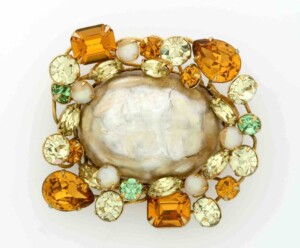Elsa Schiaparelli Jewelry (1927- 1973)
Elsa Schiaparelli was born in 1890 in Rome to a Neopolitan aristocrat mother and a Piedmontese accomplished scholar father.
In 1927 she founded the House of Schiaparelli in Paris. A leading figure of haute couture, that transformed fashion from the late 1920s to the early 1950s, rivalled only by Coco Chanel, Schiaparelli initially designed fine jewelry before establishing her couture atelier in Paris. Much like Chanel, Schiaparelli created costume jewelry pieces which were intended to compliment her couture garments; they were seen as necessary appendages to dress. The Italian designer installed provocative avant-garde artistry in her clothing and accessories, including those created with Salvador Dali, such as the lobster dress and a shoe-shaped hat.
Both, Schiaparelli’s fashion designs and her costume jewelry, reflect her fascination with the surrealist movement. Her jewelry pieces were often impressive in size, provocative in iconography, and abstract or floral themed. One of her most well-known Surrealist designs was a 1938 Rhodoid (a newly developed clear plastic) necklace studded with coloured metallic insects giving the illusion that the bugs were crawling directly on the wearer’s skin. Schiaparelli also offered brooches by Alberto Giacometti, fur-lined metal cuffs by Meret Oppenheim and pieces by Max Boinet, Lina Baretti and the writer Elsa Triolet.
Early Schiaparelli jewelry is desirable and hard to come by today. Some of these pieces, such as those from the ‘Pagan’ and ‘Circus’ collections, coordinate with clothing lines from the 1930s and the majority are unmarked. Pegan pieces incorporate a representation of insects, leaves, pinecones and other natural elements while the Circus designs focus on animals and performers. Today many of these pieces are held in museum collections.
Most of the licensed Schiaparelli jewelry pieces collectors run across now were purchased by fashionable consumers from 1949 through to the 1950s and tend to be bold designs like wide bracelets and eye-catching earrings, coordinating necklaces and brooches. Most Schiaparelli earrings from the 1950s are marked on the back of the clips. Many matching brooches, necklaces and bracelets from this period are unsigned, however.
‘Shocking Pink’ was Schiaparelli’s signature colour, used in clothing, costume jewelry and even cosmetics, with a perfume titled ‘Shocking’ (and packed in a box of the same colour) appearing in 1936. This luminous, bright pink hue was originally inspired by a jewel of that colour owned by Daisy Fellowes, an American heiress and one of Schiaparelli’s best clients.
Elsa Schiapareli’s jewelry is collected worldwide and is displayed in Museum collections such as that of the Metropolitan Museum of Art, New York and the Victoria and Albert Museum, London.
